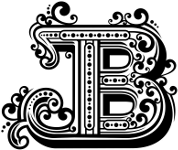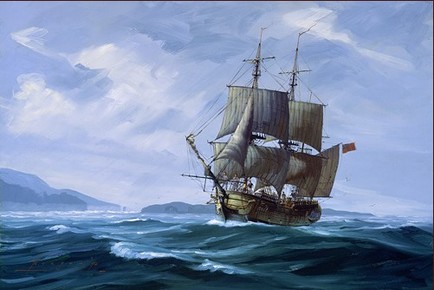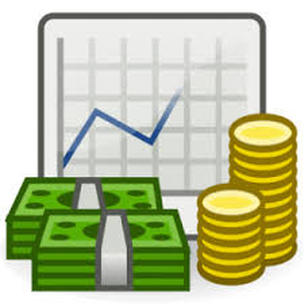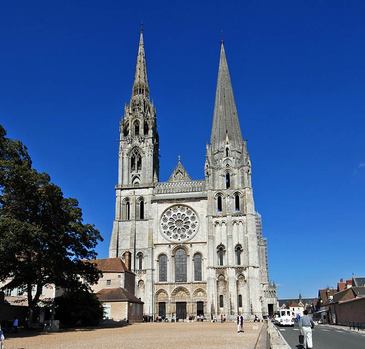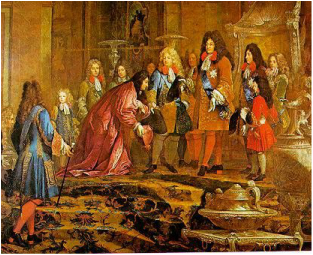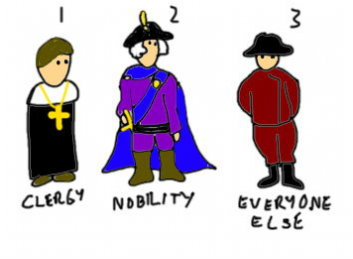The SEVEN THEMES of AP European History
THEME 1: Interaction of Europe and the World
- Why have Europeans sought contact and interaction with other parts of the world?
- What political, technological, and intellectual developments enabled European contact and interaction with other parts of the world?
- How have encounters between Europe and the world shaped European culture, politics, and society?
- What impact has contact with Europe had on non-European societies?
Yet, this critique of colonialism did not have an immediate effect, given that the 19th century proved to be a period of empire building. Driven by the needs of an industrial economy and nationalism, Europeans expanded their territorial control in Asia and Africa through warfare, the seizure of property, and, in some cases, immigration. In the late 19th century, the scale and pace of conquest intensified because of asymmetries in military technology, communications, and national rivalries among the Great Powers. In conquered territories, Europeans established new administrative, legal, and cultural institutions, and restructured colonial economies to meet European needs. These actions often led to resistance in colonial areas. Within Europe, exposure to new peoples and cultures influenced art and literature, and spurred on efforts to find a scientific basis for “racial” difference. Competition for colonies also destabilized the European balance of power and was a significant cause of World War I. In the mid–20th century, the rise of the United States as an economic and military power, two world wars, and the four-decades-long Cold War led to a decolonization movement that diminished Europe’s economic and diplomatic place in the world. At the end of the 20th century, Europe sought new ways of defining interactions among its own nations and with the rest of the world. At the same time, the migration of non-European people into Europe began to change the ethnic and religious composition of European society and to create uncertainties about European identity.
____________________________________________________________________________________________________________________________________________________________________
THEME 2: ECONOMIC AND COMMERCIAL DEVELOPMENTS (ECD)
Overarching Questions:
- How has capitalism developed as an economic system?
- How has the organization of society changed as a result of or in response to the development and spread of capitalism?
- What were the causes and consequences of economic and social inequality?
- How did individuals, groups, and the state respond to economic and social inequality?
In the centuries after 1450, Europe first entered and then gradually came to dominate a global commercial network. Building off the voyages of exploration and colonization, the Commercial Revolution of the 17th and 18th centuries involved a wide range of new financial and economic practices — such as joint-stock companies, widely capitalized banks, and triangular trade — all of which supported an emerging money economy. New commercial techniques and goods provided Europeans with an improved diet and standard of living. Wealth from commerce supported, in turn, the growth of industrial capitalism in subsequent centuries.
Commercial wealth helped transform a preindustrial economy based on guild production, cottage industry, and subsistence agriculture into one driven by market operations. While market mechanisms generated wealth and social position for some, they also destabilized traditional patterns of economic activity, such as when the wages of urban artisans and workers declined in the 16th century because of the Price Revolution. Still, commercial wealth generated resources for centralizing states, many of which, prior to the French Revolution, justified government management of trade, manufacturing, finance, and taxation through the theory of mercantilism. Mercantilism assumed that existing sources of wealth could not be expanded; accordingly, the only way to increase one’s economic power over others was to gain a greater share of the existing sources of wealth. As a result, mercantilism promoted commercial competition and warfare overseas.
Market demands generated the increasingly mechanized production of goods through the technology of the Industrial Revolution. Large-scale production required capital investment, which led to the development of capitalism, justified by Adam Smith through the concept of the “invisible hand of the marketplace.” The growth of large-scale agriculture and factories changed social and economic relations. Peasants left the countryside to work in the new factories, giving up lives as tenants on landlords’ estates for wage labor. Improved climate and diet supported a gradual population increase in the 18th century, and then came a seeming breakthrough of the Malthusian trap (the belief that population could not expand beyond the level of subsistence) with a population explosion in the industrial 19th century. Industrialization generated unprecedented levels of material prosperity for some Europeans, particularly during the Second Industrial Revolution (1850–1914), when an outburst of new technologies ushered Europe into modern mass society.
Prosperity was never equally distributed, either geographically or by social class, and despite the wonders of the railroad and airplane, poverty never disappeared. Capitalism produced its own forms of poverty and social subjection. It created financial markets that periodically crashed, putting people dependent on wages out of work and wiping out investors’ capital. Its trading system shifted production from expensive to inexpensive regions, reducing or holding down the wages of workers. By the 19th century, conditions of economic inequality and the resultant social and political instability across Europe raised questions about the role evolving nation-states could or should play in the economic lives of their subjects and citizens. Socialism argued for state ownership of property and economic planning to promote equality, and, later, Marxism developed a systematic economic and historical theory that inspired working-class movements and revolutions to overthrow the capitalist system.
The devastating impact of two world wars and the Great Depression transformed pre-1914 economic patterns and complicated the task of governments in managing the unstable economic situation. Soviet Russia and its post–World War II satellites represented one path, while nations in western and central Europe modified laissez-faire capitalism with Keynesian budget and tax policies and an expanding welfare state. Consumerism, always an important factor in economic growth, took on even more importance in the second half of the 20th century, although not without criticism. Perhaps the most significant change since World War II has been the movement toward European economic unity and a common currency. Though policies of unity have supported Europe’s postwar economic miracle, they have also encountered challenges of a stagnating population, financial crises, and growing social welfare commitments.
____________________________________________________________________________________________________________________________________________________________________
THEME 3: CULTURAL AND INTELLECTUAL DEVELOPMENTS (CID)
Overarching Questions:
- What roles have traditional sources of authority (church and classical antiquity) played in the creation and transmission of knowledge?
- How and why did Europeans come to rely on the scientific method and reason in place of traditional authorities?
- How and why did Europeans come to value subjective interpretations of reality?
____________________________________________________________________________________________________________________________________________________________________
Overarching Questions:
After 1450, the old ideal that Europe constituted a unified Christendom was weakened by the rise of sovereign states. These states asserted a monopoly over law and the management of all institutions, including the church. The growth of secular power played a critical role in the success of the Protestant Reformation, and states gained increasing influence over religious affairs. The military revolution of the early modern period forced states to find new and better sources of revenue, and it spurred the expansion of state control over political and economic functions. In the long view, war became increasingly costly, technologically sophisticated, and deadly. As Europeans expanded overseas, the theaters of European warfare expanded as well.
European polities took a variety of forms — empires, nation-states, and small republics. Absolute monarchies concentrated all authority in a single person who was regarded as divinely ordained, whereas in constitutional governments power was shared between the monarch and representative institutions. Early modern advances in education, publishing, and prosperity created “public opinion” and “civil society” independent of government, developments that supported and were promoted by Enlightenment theories of natural rights and the social contract. Political revolutions and industrialization shifted governance from monarchies and aristocracies to parliamentary institutions that both generated and embodied the rule of law while gradually widening the participation of citizens in governance through the extension of suffrage. In the late 19th century, as European states became increasingly responsive to public opinion and developed mass political parties, they ironically became impersonal and bureaucratic. After World War I, under the pressure of political and economic crises, totalitarian regimes threatened parliamentary governments.
The European state system, originating in the Peace of Westphalia and structuring interstate relations through World War I, assumed that the continent would be divided into independent sovereign states and that war and diplomacy would be the normal means of interstate relations. In the 19th century, the goal of establishing and maintaining a balance of power was challenged by the revolutionary and Napoleonic wars, the emergence of Italy and Germany as states, the weakening of traditional empires, and shifts in the alliance system. New and hardened alliances between countries driven by overseas competition and the growing influence of nationalism undermined diplomatic efforts to stave off war in the first half of the 20th century. In the 20th century, new international organizations (the League of Nations, the United Nations, NGOs) attempted to develop international law and modes of dispute resolution that would promote peace. After the catastrophe of two world wars, European states returned to the goal of a unified Europe, embodied this time not in Christendom but in the secular institutions of the European Union.
_____________________________________________________________________________________________________________________________________________
THEME 5: SOCIAL ORGANIZATION AND DEVELOPMENT (SCD)
Overarching Questions:
What forms have family, class, and social groups taken in European history, and how have they changed over time?
How and why have tensions arisen between the individual and society over the course of European history?
How and why has the status of specific groups within society changed over time?
Early modern society was divided into the three estates: clergy, nobility, and commoners, which included merchants, townspeople, as well as the overwhelming majority, the peasantry. Within those estates, family, religion, and landed wealth shaped social practices, and inequality of wealth prevailed within each estate. The poor were viewed as objects of charity or dangerous idlers requiring social control, such as disciplinary measures or confinement. Social values and communal norms were sanctified by religion. With the advent of the Reformation, new Protestant denominations contested with the Catholic Church and with each other to establish new religious practices and social values.
Marriage and family life were constrained by the values of the community. Men and especially women of all estates followed closely prescribed norms. Gathering resources to create a new household often required young adults to work and save for a period of years, and a late age of marriage for commoners (the European family pattern) tended to limit demographic growth. In preindustrial Europe, women’s and men’s work was complementary rather than separate, as peasants worked communally to bring in the harvest or artisanal women oversaw journeymen and apprentices, kept the books, and marketed the product. Despite female involvement in movements of cultural and social change, gender norms continued to stress women’s intellectual inferiority and their duty of obedience to fathers and husbands, as well as limit access to institutional power. The Protestant Reformation placed new emphasis on the individual’s direct relationship to God and the role of women in the family as mothers and assistants in religious instruction and schooling, while excluding them from clerical roles. Social and economic stresses along with negative gender stereotypes led to witchcraft persecution, which victimized elderly women in particular in the 16th and 17th centuries.
Demographic growth spurred social change in the 18th century. The Enlightenment brought a new emphasis on childhood as a stage of life, and the ideal of companionate marriage began to compete with arranged marriages. The French Revolution formally ended the division of society into three estates and continued to challenge traditional society throughout the 19th century, though remnants of the old order persisted into the 20th century. The Industrial Revolution created a division of social classes based on new criteria of capital and labor. The revolutionary emphasis on liberty galvanized many excluded groups to take an active role in politics, and the language of natural rights spurred the development of movements of equality, such as feminism and the end of feudalism and serfdom. The growth of the middle classes in the 19th century tended to anchor men and women in ”separate spheres” and the elevation of women’s role in the home into “the cult of domesticity.” Early industrialism negatively affected the working classes, and more generally shifted the family from a unit of production to one of consumption.
By the late 19th century, a new mass society had emerged defined by consumerism, expanding literacy, and new forms of leisure. The “woman question” that had emerged in the 17th century took on a new intensity as women sought economic and legal rights. World War I profoundly affected European society by conclusively ending the residual hold of old elites on power and democratizing society through shared sacrifice, represented by female suffrage in many nations. Between the wars Soviet communism theoretically endorsed equality, yet women often performed double duty as laborers and mothers, while kulaks were considered enemies of the state and thus liquidated. On the other hand, fascist regimes re-emphasized a domestic role for women and created states based on a mythical racial identity. After World War II, the welfare state emerged in Western Europe with more support for families, choices in reproduction, and state-sponsored health care. Economic recovery brought new consumer choices and popular culture. In the Soviet bloc, family life was constrained and controlled by states dedicated to heavy industry rather than consumer goods, though basic needs such as housing, health care, employment, and education were provided within an authoritarian context. The end of the Cold War and the rise of the European Union brought some shared social values to light, as well as contested issues of immigration, guest workers, and the shifting religious and ethnic balance of Europe. Immigrants sometimes challenged secularism in European life and reasserted their religious values. European society has become, with fits and starts, a pluralistic one.
THEME 6: NATIONAL AND EUROPEAN IDENTITY (NEI)
Definitions and perceptions of regional, cultural, national, and European identity have developed and been challenged over time, with varied and often profound effects on the political, social, and cultural order in Europe.
THEME 7: TECHNOLOGICAL AND SCIENTIFIC INNOVATION (TSI)
Scientific and technological innovations have increased efficiency, improved daily life, and shaped human development and interactions, having both intended and unintended consequences.
